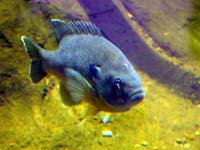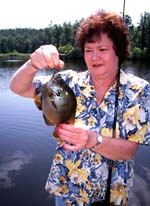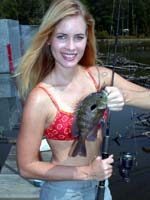BOTTOM-MOP FOR BIG BLUEGILLS
 What
Tactics Work For Bottom-Mopping What
Tactics Work For Bottom-Mopping
Editor's Note: You don't have to go to private ponds
in the South to take monster-sized bluegills. You may
find Goliath-sized 'gills right under your nose where
thousands of anglers fish every year. Many of the best
bluegill hotspots never see an angler because most of
us have believed that bluegills bed only on the banks.
However, I've learned if you want to catch this scrappy
panfish that fights hard and tastes delicious, learn
to fish offshore on deep-water structure. This week,
I'll tell you the best summer tactics for finding and
catching bluegills.
 David
Tucker of Birmingham, Alabama, uses two techniques to
mop the bottom for big bluegills. "Anytime I go
to a new lake, I fish well away from the bank, cast
toward the bank and reel my Beetle Spin jig in just
off the bottom. If I catch a big bluegill in that area,
I fan-cast all the way around that whole section of
the lake to locate the school. Often I can take a limit
of bluegills from one school of bream." If the
fish refuse to bite, Tucker will take the spinner off
the Beetle Spin jig and fish only the jig. He allows
the jig to fall to the bottom and hops the jig across
the lake bed. When I asked Tucker why he didn't buy
just the jig apart from the Beetle Spin, he replied,
"The company doesn't sell the jig or the body separately.
However, I believe the Beetle Spin's jig body design
gets more strikes when I'm bottom-mopping than any other
type of jig will." Tucker also has found the Keystone
jig will produce trophy bluegills in many lakes. When
he arrives at a lake, he studies the shallow water for
small minnows along the edge in the weeds or grass.
He selects the David
Tucker of Birmingham, Alabama, uses two techniques to
mop the bottom for big bluegills. "Anytime I go
to a new lake, I fish well away from the bank, cast
toward the bank and reel my Beetle Spin jig in just
off the bottom. If I catch a big bluegill in that area,
I fan-cast all the way around that whole section of
the lake to locate the school. Often I can take a limit
of bluegills from one school of bream." If the
fish refuse to bite, Tucker will take the spinner off
the Beetle Spin jig and fish only the jig. He allows
the jig to fall to the bottom and hops the jig across
the lake bed. When I asked Tucker why he didn't buy
just the jig apart from the Beetle Spin, he replied,
"The company doesn't sell the jig or the body separately.
However, I believe the Beetle Spin's jig body design
gets more strikes when I'm bottom-mopping than any other
type of jig will." Tucker also has found the Keystone
jig will produce trophy bluegills in many lakes. When
he arrives at a lake, he studies the shallow water for
small minnows along the edge in the weeds or grass.
He selects the  Keystone
jig instead of the Beetle Spin jig if he sees small
minnows swimming near the shore. "Bluegills prefer
to feed on small minnows," Tucker explained. "The
Keystone jig closely resembles a small minnow. By fishing
it close to the bottom in the deep water, I can catch
big bluegills." Keystone
jig instead of the Beetle Spin jig if he sees small
minnows swimming near the shore. "Bluegills prefer
to feed on small minnows," Tucker explained. "The
Keystone jig closely resembles a small minnow. By fishing
it close to the bottom in the deep water, I can catch
big bluegills."
When To Use Wooden Corks For Big Bluegills:
If bluegills don't readily take the jigs, Tucker will
employ his slip-cork, bottom-mopping technique. Keeping
his boat well away from the site where he thinks the
bluegills hold, Tucker will make a long cast using a
heavy wooden cork, allowing his line to fall from the
cork to the depths he wants to fish. "I use the
wooden cork to provide the weight I need to make a long
cast," Tucker advised. "I use as little lead
as possible, 8 to  10
inches up the line, to allow the live red worms to sink
to the bottom. I occasionally move the worms along the
bottom, but the cork still will lay flat on the surface
of the water. My cork doesn't suspend my bait up off
the bottom but merely acts as a strike indicator. When
the bluegills don't want to bite, I stay well away from
them and make long casts to mop the bottom with live
red worms. This technique will produce both bluegills
and shellcrackers when jigs won't." Tucker can
catch big bluegills and shellcrackers (redear sunfish)
all year. Tucker explains, "I can still catch the
big bluegills during the hot months, but they move out
into deeper water, often 12- to 15- feet deep." 10
inches up the line, to allow the live red worms to sink
to the bottom. I occasionally move the worms along the
bottom, but the cork still will lay flat on the surface
of the water. My cork doesn't suspend my bait up off
the bottom but merely acts as a strike indicator. When
the bluegills don't want to bite, I stay well away from
them and make long casts to mop the bottom with live
red worms. This technique will produce both bluegills
and shellcrackers when jigs won't." Tucker can
catch big bluegills and shellcrackers (redear sunfish)
all year. Tucker explains, "I can still catch the
big bluegills during the hot months, but they move out
into deeper water, often 12- to 15- feet deep."
TOMORROW: CATCH FIRECRACKER BREAM WITH OUTER-SPACE
TECHNOLOGY
|
